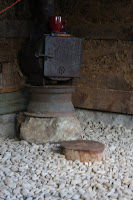Wood-Fired Barrel Oven Video
This oven project was led by Eva Edleson at the Natural Building Extravaganza!
Learn more about...
This oven project was led by Eva Edleson at the Natural Building Extravaganza!
Naturally Building for Fire
March 3 – 6, 2010
Come see how little wood it takes to warm your home while creating a lovely hearth.
Join us in building a multi-functional and beautiful masonry heater using natural building techniques. Masonry heaters are highly efficient fireplaces which are designed to burn cleanly and and maintain much more of the heat inside your home. They provide a comfortable and environmentally-sound way to heat your home. Our project will use affordable earthen materials while also incorporating traditional European stove design and modern methods used in the United States.
Cost: $400
NATURAL FINISHES: PLASTERS, PAINTS, FRESCOES, ETC.
March 10 – 13, 2010
Come join us as we make and apply a plaster coat on our new community kitchen.
Learn how to use local, natural materials to craft many types of beautiful finishes. This course will include information about various interior and exterior treatments as well as tool and application techniques.
Cost: $400

Program included:
Introduction to Permaculture
Permaculture and Natural Building
Passive Solar Design
Introduction to Natural Building
Composting Toilets
Solar Water Heating
Grey Water Treatment
Sacred Geometry
Electricity
Green or Living Roofs
Geodesic Domes
Natural Building Techniques Covered:
Adobe Brick
Wattle and Daub
Light Straw-Clay Bricks
Earth Bag Construction
Cob
Natural Plasters
Earthen Sculpture
Tile Mosaic
Natural Paints
Insulating Panels
Cast Floor Panels







CIDEP, which stands for Center for Permaculture Research, Development and Education, is the central location for both hands-on projects and lectures. The center is a 24 acre farm in a beautiful rural area at the foothills of the Andes and 9 miles from the center of the town of El Bolson. Many sustainable systems at various stages of development exist at the center including natural windbreaks, natural buildings, alternative energy generation, passive solar systems, composting toilets, recycling, garden, and nature reserve spaces. The presence of all these systems creates a dynamic environment for participants since they actually live in and experience them.
 The Fuddy ceiling is made of corrugated metal.
The Fuddy ceiling is made of corrugated metal. Then we put pond liner on the roof and covered it with a thick mulch.
Then we put pond liner on the roof and covered it with a thick mulch. Putting in the drainage layer with Noah.
Putting in the drainage layer with Noah. The wood stove with built in wood block for chopping kindling.
The wood stove with built in wood block for chopping kindling. Jur and Natalie putting in the earthen base floor.
Jur and Natalie putting in the earthen base floor. This is what it looks like inside the Fuddy right now.
This is what it looks like inside the Fuddy right now.